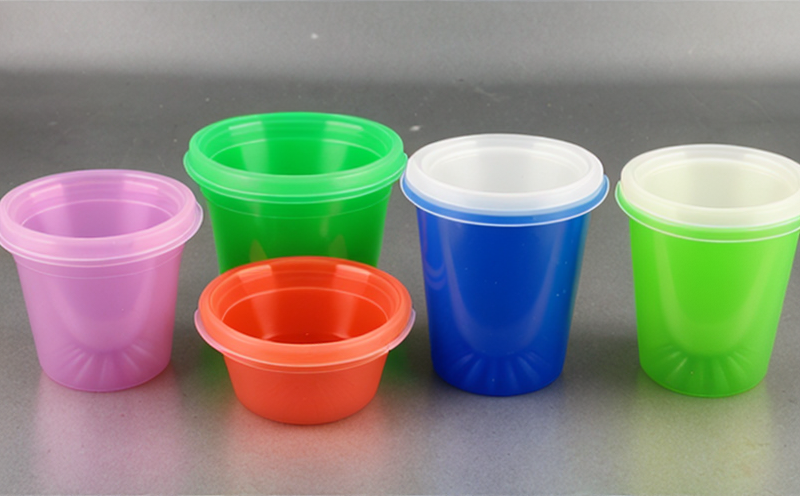EN 1186 Food Contact Migration Testing of Disposable Plastics
The European standard EN 1186 provides a framework for ensuring that disposable plastics intended to come into contact with food do not release harmful substances. This testing ensures the safety and quality of materials used in packaging, containers, and utensils. The test assesses the migration of chemicals from these items into food during storage or use.
Food contact migration is a critical concern because certain additives, stabilizers, plasticizers, colorants, and other substances can leach into food when the packaging material comes into direct contact with it. This can lead to contamination that poses risks to consumer health. Therefore, regulatory compliance through rigorous testing ensures public safety.
The test procedure outlined in EN 1186 involves placing a sample of the disposable plastic item into a defined food simulant. The simulant mimics the conditions under which the material would be used—such as temperature and duration of contact. After exposure, the sample is analyzed to determine if any detectable levels of migratory substances have entered the food simulant.
The standard covers various types of disposable plastics commonly found in the market, including polyethylene (PE), polystyrene (PS), polypropylene (PP), and more. It also includes specific criteria for testing different packaging forms such as cups, plates, containers, lids, and utensils.
Compliance with EN 1186 is essential for manufacturers of disposable plastic products that intend to sell their items in the European Union or other regions where this standard applies. Failure to meet these requirements can result in product recalls, loss of market access, and potential legal consequences.
- Why Choose This Test?
- To ensure compliance with international safety standards
- To protect consumer health by preventing harmful substance migration into food
- To maintain brand reputation through consistent product quality
- To avoid costly recalls and legal actions due to non-compliance
- To facilitate market access in Europe and other regions
- To enhance the credibility of your products with regulatory bodies and consumers
Applied Standards
The primary standard used for this testing is EN 1186, which specifies the requirements for ensuring that disposable plastics intended to come into contact with food do not release harmful substances. This standard includes detailed protocols and acceptance criteria tailored specifically for food-contact materials.
In addition to EN 1186, other relevant standards such as ISO 21547-1:2013 may also be applicable depending on the specific type of plastic or its intended use. These international standards provide additional guidance on test methods and acceptance criteria, ensuring consistent testing across different regions.
It is important to note that while EN 1186 sets out broad requirements, individual countries within the European Union may have their own national regulations and guidelines that supplement or diverge slightly from this standard. Therefore, it is crucial for manufacturers to consult with local regulatory authorities to ensure full compliance.
For detailed information on specific test methods and acceptance criteria, refer to Annex A of EN 1186. This annex provides guidance on the selection of food simulants, the duration of contact periods, and the analytical techniques used for detecting migratory substances.
Scope and Methodology
The scope of EN 1186 covers disposable plastics intended to come into direct or indirect contact with food. This includes packaging materials, utensils, and containers that are used in food preparation, storage, or serving. The test focuses on identifying any potential migration of substances from these items into the food.
The methodology involves several key steps:
- Selection of appropriate food simulants based on the type of plastic and its intended use
- Contact with the selected simulant under defined conditions (temperature, time)
- Analysis of the food simulant to detect any migratory substances using suitable analytical techniques such as gas chromatography-mass spectrometry (GC-MS) or high-performance liquid chromatography (HPLC)
- Evaluation against the specified limits set forth in EN 1186
The test is conducted on a representative sample of the disposable plastic item, ensuring that the results are indicative of the entire batch or production run. The sample preparation involves cutting the material into appropriate pieces and placing them into the food simulant according to the specified conditions.
After the contact period, the simulants are analyzed for any detectable levels of migratory substances. Acceptance criteria are defined in EN 1186 based on recognized safety limits set by regulatory authorities. If the detected levels fall within these limits, the product is considered compliant with the standard.
It is important to note that the test does not aim to completely eliminate all migration but rather to ensure that it remains at safe and acceptable levels. The standard provides a balance between allowing necessary additives for processing and ensuring food safety.





